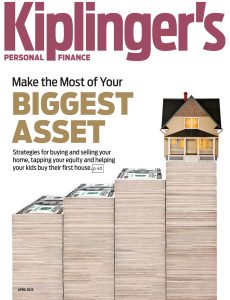
Kiplinger’s Personal Finance – April 2023
English | 77 pages | pdf | 22.66 MB
Welcome Kiplinger’s Personal Finance Magazine April 2023 Issue
Spring is the traditional time to buy and sell a home, but advice for buyers and sellers is only a part of our cover-story package on profiting from your home, starting on page 40. We know that our readers, who tend to be established and settled, aren’t trading up (or down) all that often. Many of you have also paid off your mortgage.
So we focus on the changing value of the most expensive purchase you’ve ever made. Plus, we explore smart ways to tap your equity, including a reverse mortgage, which can provide retirement income or temporary cash while investments recover from a down market. We also explain financially sound ways to help a first-time buyer, such as a son or daughter, make the leap to homeownership.
A changing real estate market. The pandemic played havoc with the housing market. As remote and hybrid work became the norm, workers formerly tethered to the office bought homes in far-flung suburbs and even states far from their workplace. Urban condos lost value, and single-family homes shot up in price, aided by superlow mortgage rates and tight supply.
From January 2020 through the end of 2022, the national median sale price of existing homes jumped nearly 40%, although the appreciation slowed considerably in 2022 after mortgage rates spiked.
That has padded the equity in your homes considerably. According to ATTOM, a provider of real estate data, 48% of U.S. homes with mortgages were considered “equity-rich” in the fourth quarter of 2022, meaning that the combined loan balances secured by those properties was no more than half their estimated market value. The number of equity-rich properties has doubled over the past three years.
It’s a different story for commercial real estate. Large-city downtowns turned into ghost towns during the
lockdown three years ago, and many urban hubs are still eerily quiet, especially on Mondays and Fridays. The Kastle Back to Work Barometer, from the access-card company, tracks the weekday average of employees who swipe into the buildings it serves in the 10 largest U.S. cities. The 10-city average hit 50% of pre-pandemic activity at the end of January—the highest since the lockdowns.
Chicago and Texas cities have the highest swipe rates. Cities on both coasts have the lowest. That includes my hometown of Washington, D.C.
As in other cities, D.C.’s empty office buildings and vacant storefronts are dinging revenues, as owners of buildings with high vacancies challenge tax assessments. D.C.’s mayor is talking about turning commercial space into apartments, but that doesn’t always work without new construction because office buildings have a shortage of windows.
This is a long windup to my news that Kiplinger’s Personal Finance Magazine has closed its D.C. office, and the staff is now fully remote. Our parent company did the math, and our new digs, completed just days before the lockdown in March 2020, didn’t have enough workers to justify keeping the lights on. Our U.S. headquarters are now in New York City (the mailing address is on page 5). The pandemic forced us to make use of new technology and procedures to publish the magazine and communicate with each other remotely, so there will be no disruption for readers and few ramifications for our staff—other than, for me at least, a wistful nostalgia for water cooler conversations and my old, windowed office.
Download from: